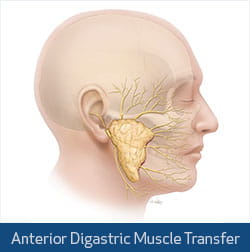Digastric Muscle Transfer
Production of a full smile requires both the elevation of the upper lip and a slight depression of the lower lip. Loss of this downward motion of the lower lip produces an uneven smile and loss of facial harmony. Lower lip weakness usually results from division of the facial nerve (marginal mandibular branch) during a face lift or cancer surgery. Alternately, the functional loss can be congenital in nature.
In cases of isolated lower lip weakness one portion of the digastric muscle can be transferred to the lower lip to restore lip depression. This muscle transfer is possible because the digastric muscle has two sources of innervation. The posterior portion of the digastric muscle is innervated by the facial nerve and its anterior segment receives its motor nerve supply from the mylohyoid nerve. The independent innervation of the anterior segment of the muscle allows it to remain functional in the presence of a facial nerve paralysis and to be redirected in an effort to reestablish lower lip depression.
Technique

Recovery
A single overnight stay in the hospital is usually required after a digastric muscle transfer. Patients are asked to follow a soft diet and avoid exercise, heavy lifting and brushing their teeth until cleared by the operating surgeon. A home physical therapy program is initiated after the initial healing phases in an effort to achieve natural appearing downward movement of the lip.
real patient case studies
Learn how facial paralysis surgery and functional restoration can help you.
